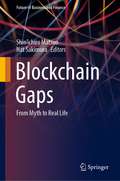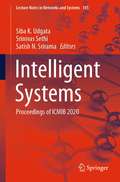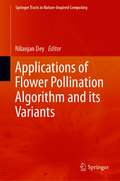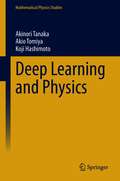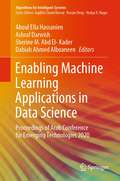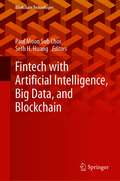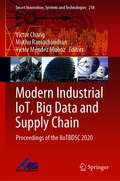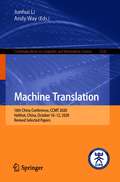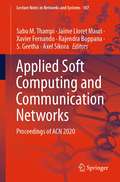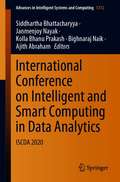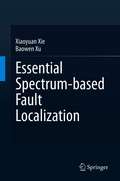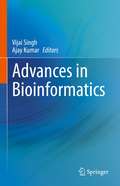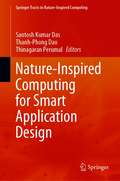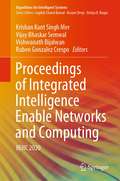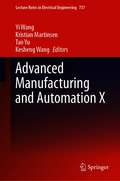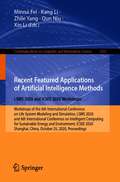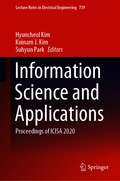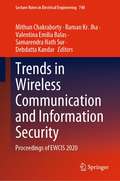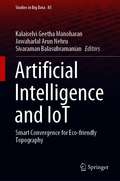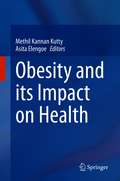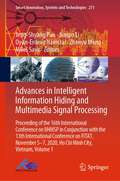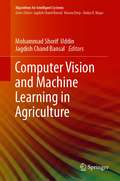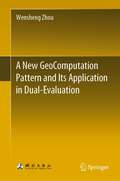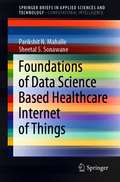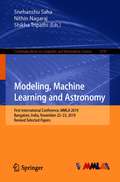- Table View
- List View
Blockchain Gaps: From Myth to Real Life (Future of Business and Finance)
by Shin’ichiro Matsuo Nat SakimuraThis book analyzes the fundamental issues faced when blockchain technology is applied to real-life applications. These concerns, not only in the realm of computer science, are caused by the nature of technological design. Blockchain is considered the foundation of a wide range of flexible ecosystems; its technology is an excellent mixture of mathematics, cryptography, incentive mechanisms, economics, and pertinent regulations. The book provides an essential understanding of why such fundamental issues arise, by revising the underlying theories. Blockchain theory is thus presented in an easy-to-understand, useful manner. Also explained is the reason why blockchain is hard to adopt for real-life problems but is valuable as a foundation for flexible ecosystems. Included are directions for solving those problems and finding suitable areas for blockchain applications in the future. The authors of this work are experts from a wide range of backgrounds such as cryptography, distributed computing, computer science, trust, identity, regulation, and standardization. Their contributions collected here will appeal to all who are interested in blockchain and the elements surrounding it.
Intelligent Systems: Proceedings of ICMIB 2020 (Lecture Notes in Networks and Systems #185)
by Siba K. Udgata Srinivas Sethi Satish N. SriramaThis book features best selected research papers presented at the International Conference on Machine Learning, Internet of Things and Big Data (ICMIB 2020) held at Indira Gandhi Institute of Technology, Sarang, India, during September 2020. It comprises high-quality research work by academicians and industrial experts in the field of machine learning, mobile computing, natural language processing, fuzzy computing, green computing, human–computer interaction, information retrieval, intelligent control, data mining and knowledge discovery, evolutionary computing, IoT and applications in smart environments, smart health, smart city, wireless networks, big data, cloud computing, business intelligence, internet security, pattern recognition, predictive analytics applications in healthcare, sensor networks and social sensing and statistical analysis of search techniques.
Applications of Flower Pollination Algorithm and its Variants (Springer Tracts in Nature-Inspired Computing)
by Nilanjan DeyThis book presents essential concepts of traditional Flower Pollination Algorithm (FPA) and its recent variants and also its application to find optimal solution for a variety of real-world engineering and medical problems. Swarm intelligence-based meta-heuristic algorithms are extensively implemented to solve a variety of real-world optimization problems due to its adaptability and robustness. FPA is one of the most successful swarm intelligence procedures developed in 2012 and extensively used in various optimization tasks for more than a decade. The mathematical model of FPA is quite straightforward and easy to understand and enhance, compared to other swarm approaches. Hence, FPA has attracted attention of researchers, who are working to find the optimal solutions in variety of domains, such as N-dimensional numerical optimization, constrained/unconstrained optimization, and linear/nonlinear optimization problems. Along with the traditional bat algorithm, the enhanced versions of FPA are also considered to solve a variety of optimization problems in science, engineering, and medical applications.
Deep Learning and Physics (Mathematical Physics Studies)
by Akinori Tanaka Akio Tomiya Koji HashimotoWhat is deep learning for those who study physics? Is it completely different from physics? Or is it similar? In recent years, machine learning, including deep learning, has begun to be used in various physics studies. Why is that? Is knowing physics useful in machine learning? Conversely, is knowing machine learning useful in physics? This book is devoted to answers of these questions. Starting with basic ideas of physics, neural networks are derived naturally. And you can learn the concepts of deep learning through the words of physics.In fact, the foundation of machine learning can be attributed to physical concepts. Hamiltonians that determine physical systems characterize various machine learning structures. Statistical physics given by Hamiltonians defines machine learning by neural networks. Furthermore, solving inverse problems in physics through machine learning and generalization essentially provides progress and even revolutions in physics. For these reasons, in recent years interdisciplinary research in machine learning and physics has been expanding dramatically. This book is written for anyone who wants to learn, understand, and apply the relationship between deep learning/machine learning and physics. All that is needed to read this book are the basic concepts in physics: energy and Hamiltonians. The concepts of statistical mechanics and the bracket notation of quantum mechanics, which are explained in columns, are used to explain deep learning frameworks.We encourage you to explore this new active field of machine learning and physics, with this book as a map of the continent to be explored.
Enabling Machine Learning Applications in Data Science: Proceedings of Arab Conference for Emerging Technologies 2020 (Algorithms for Intelligent Systems)
by Aboul Ella Hassanien Ashraf Darwish Sherine M. Abd El-Kader Dabiah Ahmed AlboaneenThis book gathers selected high-quality research papers presented at Arab Conference for Emerging Technologies 2020 organized virtually in Cairo during 21–23 June 2020. This book emphasizes the role and recent developments in the field of emerging technologies and artificial intelligence, and related technologies with a special focus on sustainable development in the Arab world. The book targets high-quality scientific research papers with applications, including theory, practical, prototypes, new ideas, case studies and surveys which cover machine learning applications in data science.
Fintech with Artificial Intelligence, Big Data, and Blockchain (Blockchain Technologies)
by Paul Moon Sub Choi Seth H. HuangThis book introduces readers to recent advancements in financial technologies. The contents cover some of the state-of-the-art fields in financial technology, practice, and research associated with artificial intelligence, big data, and blockchain—all of which are transforming the nature of how products and services are designed and delivered, making less adaptable institutions fast become obsolete. The book provides the fundamental framework, research insights, and empirical evidence in the efficacy of these new technologies, employing practical and academic approaches to help professionals and academics reach innovative solutions and grow competitive strengths.
Modern Industrial IoT, Big Data and Supply Chain: Proceedings of the IIoTBDSC 2020 (Smart Innovation, Systems and Technologies #218)
by Victor Chang Muthu Ramachandran Víctor Méndez MuñozThis book is a collection of selected papers presented at the First International Conference on Industrial IoT, Big Data and Supply Chain (IIoTBDSC), held as an online conference due to COVID-19 (initially to be held in Macao, Special Administration Region (SAR) of China), during September 15–17, 2020. It includes novel and innovative work from experts, practitioners, scientists and decision-makers from academia and industry. It brings multi-disciplines together on IIoT, data science, cloud computing, software engineering approaches to design, development, testing and quality of products and services.
Machine Translation: 16th China Conference, CCMT 2020, Hohhot, China, October 10-12, 2020, Revised Selected Papers (Communications in Computer and Information Science #1328)
by Junhui Li Andy WayThis book constitutes the refereed proceedings of the 16th China Conference on Machine Translation, CCMT 2020, held in Hohhot, China, in October 2020. The 13 papers presented in this volume were carefully reviewed and selected from 78 submissions and focus on all aspects of machine translation, including preprocessing, neural machine translation models, hybrid model, evaluation method, and post-editing.
Applied Soft Computing and Communication Networks: Proceedings of ACN 2020 (Lecture Notes in Networks and Systems #187)
by Sabu M. Thampi Jaime Lloret Mauri Xavier Fernando Rajendra Boppana S. Geetha Axel SikoraThis book constitutes thoroughly refereed post-conference proceedings of the International Applied Soft Computing and Communication Networks (ACN 2020) held in VIT, Chennai, India, during October 14–17, 2020. The research papers presented were carefully reviewed and selected from several initial submissions. The book is directed to the researchers and scientists engaged in various fields of intelligent systems.
International Conference on Intelligent and Smart Computing in Data Analytics: ISCDA 2020 (Advances in Intelligent Systems and Computing #1312)
by Siddhartha Bhattacharyya Janmenjoy Nayak Kolla Bhanu Prakash Bighnaraj Naik Ajith AbrahamThis book is a collection of best selected research papers presented at International Conference on Intelligent and Smart Computing in Data Analytics (ISCDA 2020), held at K L University, Guntur, Andhra Pradesh, India. The primary focus is to address issues and developments in advanced computing, intelligent models and applications, smart technologies and applications. It includes topics such as artificial intelligence and machine learning, pattern recognition and analysis, computational intelligence, signal and image processing, bioinformatics, ubiquitous computing, genetic fuzzy systems, hybrid evolutionary algorithms, nature-inspired smart hybrid systems, Internet of things, industrial IoT, health informatics, human–computer interaction and social network analysis. The book presents innovative work by leading academics, researchers and experts from industry.
Essential Spectrum-based Fault Localization
by Xiaoyuan Xie Baowen XuProgram debugging has always been a difficult and time-consuming task in the context of software development, where spectrum-based fault localization (SBFL) is one of the most widely studied families of techniques. While it’s not particularly difficult to learn about the process and empirical performance of a particular SBFL technique from the available literature, researchers and practitioners aren’t always familiar with the underlying theories. This book provides the first comprehensive guide to fundamental theories in SBFL, while also addressing some emerging challenges in this area. The theoretical framework introduced here reveals the intrinsic relations between various risk evaluation formulas, making it possible to construct a formula performance hierarchy. Further extensions of the framework provide a sufficient and necessary condition for a general maximal formula, as well as performance comparisons for hybrid SBFL methods. With regard to emerging challenges in SBFL, the book mainly covers the frequently encountered oracle problem in SBFL and introduces a metamorphic slice-based solution. In addition, it discusses the challenge of multiple-fault localization and presents cutting-edge approaches to overcoming it. SBFL is a widely studied research area with a massive amount of publications. Thus, it is essential that the software engineering community, especially those involved in program debugging, software maintenance and software quality assurance (including both newcomers and researchers who want to gain deeper insights) understand the most fundamental theories – which could also be very helpful to ensuring the healthy development of the field.
Advances in Bioinformatics
by Vijai Singh Ajay KumarThis book presents the latest developments in bioinformatics, highlighting the importance of bioinformatics in genomics, transcriptomics, metabolism and cheminformatics analysis, as well as in drug discovery and development. It covers tools, data mining and analysis, protein analysis, computational vaccine, and drug design. Covering cheminformatics, computational evolutionary biology and the role of next-generation sequencing and neural network analysis, it also discusses the use of bioinformatics tools in the development of precision medicine. This book offers a valuable source of information for not only beginners in bioinformatics, but also for students, researchers, scientists, clinicians, practitioners, policymakers, and stakeholders who are interested in harnessing the potential of bioinformatics in many areas.
Nature-Inspired Computing for Smart Application Design (Springer Tracts in Nature-Inspired Computing)
by Santosh Kumar Das Thanh-Phong Dao Thinagaran PerumalThis book focuses primarily on the nature-inspired approach for designing smart applications. It includes several implementation paradigms such as design and path planning of wireless network, security mechanism and implementation for dynamic as well as static nodes, learning method of cloud computing, data exploration and management, data analysis and optimization, decision taking in conflicting environment, etc. The book fundamentally highlights the recent research advancements in the field of engineering and science.
Proceedings of Integrated Intelligence Enable Networks and Computing: IIENC 2020 (Algorithms for Intelligent Systems)
by Krishan Kant Singh Mer Vijay Bhaskar Semwal Vishwanath Bijalwan Rubén González CrespoThis book presents best selected research papers presented at the First International Conference on Integrated Intelligence Enable Networks and Computing (IIENC 2020), held from May 25 to May 27, 2020, at the Institute of Technology, Gopeshwar, India (Government Institute of Uttarakhand Government and affiliated to Uttarakhand Technical University). The book includes papers in the field of intelligent computing. The book covers the areas of machine learning and robotics, signal processing and Internet of things, big data and renewable energy sources.
Advanced Manufacturing and Automation X (Lecture Notes in Electrical Engineering #737)
by Yi Wang Kesheng Wang Tao Yu Kristian MartinsenThis book presents selected papers from the 10th International Workshop of Advanced Manufacturing and Automation (IWAMA 2020), held in Zhanjiang, Guangdong province, China, on October 12-13, 2020. Discussing topics such as novel techniques for manufacturing and automation in Industry 4.0 and smart factories, which are vital for maintaining and improving economic development and quality of life, it offers researchers and industrial engineers insights into implementing the concepts and theories of Industry 4.0, in order to effectively respond to the challenges posed by the 4th industrial revolution and smart factories.
Recent Featured Applications of Artificial Intelligence Methods. LSMS 2020 and ICSEE 2020 Workshops: Workshops of the 6th International Conference on Life System Modeling and Simulation, LSMS 2020, and 6th International Conference on Intelligent Computing for Sustainable Energy and Environment, ICSEE 2020, Shanghai, China, October 25, 2020, Proceedings (Communications in Computer and Information Science #1303)
by Minrui Fei Kang Li Zhile Yang Qun Niu Xin LiThis book constitutes the thoroughly refereed proceedings of the themed workshops of the 6th International Conference on Life System Modeling and Simulation, LSMS 2020, and of the 6th International Conference on Intelligent Computing for Sustainable Energy and Environment, ICSEE 2020, held in Hangzhou, China, in October 2020.The 36 full and 2 short papers presented were carefully reviewed and selected from over 165 submissions. The papers of this volume are organized in topical sections on: smart energy systems and devices; intelligent manufacturing and systems; and intelligent biology and information systems.
Information Science and Applications: Proceedings of ICISA 2020 (Lecture Notes in Electrical Engineering #739)
by Hyuncheol Kim Kuinam J. Kim Suhyun ParkThis book presents select proceedings of 11th International Conference on Information Science and Applications 2020 (ICISA 2020) and provides a snapshot of the latest issues encountered in technical convergence and convergences of security technology. It explores how information science is core to most current research, industrial and commercial activities and consists of contributions covering topics including Ubiquitous Computing, Networks and Information Systems, Multimedia and Visualization, Middleware and Operating Systems, Security and Privacy, Data Mining and Artificial Intelligence, Software Engineering, and Web Technology. Also the proceedings introduce the most recent information technology and ideas, applications and problems related to technology convergence, illustrated through case studies, and reviews converging existing security techniques. Through this book, readers can gain an understanding of the current state-of-the-art information strategies and technologies of convergence security.
Trends in Wireless Communication and Information Security: Proceedings of EWCIS 2020 (Lecture Notes in Electrical Engineering #740)
by Mithun Chakraborty Raman Kr. Jha Valentina Emilia Balas Samarendra Nath Sur Debdatta KandarThis book presents best selected papers presented at the International Conference on Emerging Wireless Communication Technologies and Information Security (EWCIS 2020), held from 8th & 9th October 2020 at Amity University Jharkhand, Ranchi, India. The book includes papers in the research area of wireless communications and intelligent systems, signal and image processing in engineering applications, data communication and information security, IoT and cloud computing. The contribution ranges from scientists, engineers and technologists from academia as well as from industry.
Artificial Intelligence and IoT: Smart Convergence for Eco-friendly Topography (Studies in Big Data #85)
by Kalaiselvi Geetha Manoharan Jawaharlal Arun Nehru Sivaraman BalasubramanianThis book projects a futuristic scenario that is more existent than they have been at any time earlier. To be conscious of the bursting prospective of IoT, it has to be amalgamated with AI technologies. Predictive and advanced analysis can be made based on the data collected, discovered and analyzed. To achieve all these compatibility, complexity, legal and ethical issues arise due to automation of connected components and gadgets of widespread companies across the globe. While these are a few examples of issues, the authors’ intention in editing this book is to offer concepts of integrating AI with IoT in a precise and clear manner to the research community. In editing this book, the authors’ attempt is to provide novel advances and applications to address the challenge of continually discovering patterns for IoT by covering various aspects of implementing AI techniques to make IoT solutions smarter. The only way to remain pace with this data generated by the IoT and acquire the concealed acquaintance it encloses is to employ AI as the eventual catalyst for IoT. IoT together with AI is more than an inclination or existence; it will develop into a paradigm. It helps those researchers who have an interest in this field to keep insight into different concepts and their importance for applications in real life. This has been done to make the edited book more flexible and to stimulate further interest in topics. All these motivated the authors toward integrating AI in achieving smarter IoT. The authors believe that their effort can make this collection interesting and highly attract the student pursuing pre-research, research and even master in multidisciplinary domain.
Obesity and its Impact on Health
by Methil Kannan Kutty Asita ElengoeThis book summarizes the effects of obesity on health and its correlation with a wide range of debilitating and life-threatening conditions in humans. It discusses the possible pathological mechanisms that are involved in the development of obesity and highlights obesity-associated molecular mechanisms that contribute to reproductive dysfunctions in men and women. The book provides mechanistic insights on the role of obesity in cardiovascular and respiratory disorders, and examines the role of the complementary molecular mechanism of the gut microbiota in the development of obesity. It also reviews the interaction between the metabolic system and immune cells in the pathogenesis of obesity-associated diseases. Lastly, it assesses the latest advances in nanomedicine as an emerging strategy for the treatment of obesity.
Advances in Intelligent Information Hiding and Multimedia Signal Processing: Proceeding of the 16th International Conference on IIHMSP in conjunction with the 13th international conference on FITAT, November 5-7, 2020, Ho Chi Minh City, Vietnam, Volume 1 (Smart Innovation, Systems and Technologies #211)
by Jeng-Shyang Pan Jianpo Li Oyun-Erdene Namsrai Zhenyu Meng Miloš SavićThis book presents selected papers from the Sixteenth International Conference on Intelligent Information Hiding and Multimedia Signal Processing, in conjunction with the Thirteenth International Conference on Frontiers of Information Technology, Applications and Tools, held on November 5–7, 2020, in Ho Chi Minh City, Vietnam. It is divided into two volumes and discusses the latest research outcomes in the field of Information Technology (IT) including information hiding, multimedia signal processing, big data, data mining, bioinformatics, database, industrial and Internet of things, and their applications.
Computer Vision and Machine Learning in Agriculture (Algorithms for Intelligent Systems)
by Mohammad Shorif Uddin Jagdish Chand BansalThis book discusses computer vision, a noncontact as well as a nondestructive technique involving the development of theoretical and algorithmic tools for automatic visual understanding and recognition which finds huge applications in agricultural productions. It also entails how rendering of machine learning techniques to computer vision algorithms is boosting this sector with better productivity by developing more precise systems. Computer vision and machine learning (CV-ML) helps in plant disease assessment along with crop condition monitoring to control the degradation of yield, quality, and severe financial loss for farmers. Significant scientific and technological advances have been made in defect assessment, quality grading, disease recognition, pests, insects, fruits, and vegetable types recognition and evaluation of a wide range of agricultural plants, crops, leaves, and fruits. The book discusses intelligent robots developed with the touch of CV-ML which can help farmers to perform various tasks like planting, weeding, harvesting, plant health monitoring, and so on. The topics covered in the book include plant, leaf, and fruit disease detection, crop health monitoring, applications of robots in agriculture, precision farming, assessment of product quality and defects, pest, insect, fruits, and vegetable types recognition.
A New GeoComputation Pattern and Its Application in Dual-Evaluation
by Wensheng ZhouThis book introduces Document As System (DAS), a new GeoComputation pattern, which is also a new GIS application pattern. It uses the GeoComputation language (G language) to describe and execute complex spatial analysis model in the MS Word environment, which solves the bottleneck problem of GIS application, makes GIS become a popular tool for spatial data analysis from the spatial data visualization tool, and plays an important role in the wide application of GIS technology. This book systematically introduces the theory related to the new GeoComputation pattern and the application example in the “dual-evaluation” of territorial and spatial planning, which can be used as a learning and reference manual for GIS related professionals and business personnel engaged in the “dual-evaluation” of territorial and spatial planning.
Foundations of Data Science Based Healthcare Internet of Things (SpringerBriefs in Applied Sciences and Technology)
by Parikshit N. Mahalle Sheetal S. SonawaneThis book offers a basic understanding of the Internet of Things (IoT), its design issues and challenges for healthcare applications. It also provides details of the challenges of healthcare big data, role of big data in healthcare and techniques, and tools for IoT in healthcare. This book offers a strong foundation to a beginner. All technical details that include healthcare data collection unit, technologies and tools used for the big data analytics implementation are explained in a clear and organized format.
Modeling, Machine Learning and Astronomy: First International Conference, MMLA 2019, Bangalore, India, November 22–23, 2019, Revised Selected Papers (Communications in Computer and Information Science #1290)
by Snehanshu Saha Nithin Nagaraj Shikha TripathiThis book constitutes the proceedings of the First International Conference on Modeling, Machine Learning and Astronomy, MMLA 2019, held in Bangalore, India, in November 2019.The 11 full papers and 3 short papers presented in this volume were carefully reviewed and selected from 63 submissions. They are organized in topical sections on modeling and foundations; machine learning applications; astronomy and astroinformatics.
